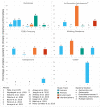Community-Acquired Antimicrobial Resistant Enterobacteriaceae in Central America: A One Health Systematic Review
- PMID: 33086731
- PMCID: PMC7589814
- DOI: 10.3390/ijerph17207622
Community-Acquired Antimicrobial Resistant Enterobacteriaceae in Central America: A One Health Systematic Review
Abstract
Community-acquired antimicrobial resistant Enterobacteriaceae (CA-ARE) are an increasingly important issue around the world. Characterizing the distribution of regionally specific patterns of resistance is important to contextualize and develop locally relevant interventions. This systematic review adopts a One Health framework considering the health of humans, animals, and the environment to describe CA-ARE in Central America. Twenty studies were identified that focused on antimicrobial resistance (AMR) in Enterobacteriaceae. Studies on CA-ARE in Central America characterized resistance from diverse sources, including humans (n = 12), animals (n = 4), the environment (n = 2), and combinations of these categories (n = 2). A limited number of studies assessed prevalence of clinically important AMR, including carbapenem resistance (n = 3), third generation cephalosporin resistance (n = 7), colistin resistance (n = 2), extended spectrum beta-lactamase (ESBL) production (n = 4), or multidrug resistance (n = 4). This review highlights significant gaps in our current understanding of CA-ARE in Central America, most notably a general dearth of research, which requires increased investment and research on CA-ARE as well as AMR more broadly.
Keywords: Central America; Enterobacteriaceae; One Health; antimicrobial resistance.
Conflict of interest statement
The authors declare no conflict of interest. We do not have any commercial association that might create a conflict of interest in connection with the submitted manuscript.
Figures



Similar articles
-
Beta-lactamases in Enterobacteriaceae infections in children.J Infect. 2016 Jul 5;72 Suppl:S41-9. doi: 10.1016/j.jinf.2016.04.021. Epub 2016 May 11. J Infect. 2016. PMID: 27180312 Review.
-
Geographic mapping of Enterobacteriaceae with extended-spectrum β-lactamase (ESBL) phenotype in Pereira, Colombia.BMC Infect Dis. 2020 Jul 23;20(1):540. doi: 10.1186/s12879-020-05267-1. BMC Infect Dis. 2020. PMID: 32703276 Free PMC article.
-
Prevalence and risk factors of infections caused by extended-spectrum β-lactamase (ESBL)-producing Enterobacteriaceae.J Infect Chemother. 2016 May;22(5):319-26. doi: 10.1016/j.jiac.2016.02.004. Epub 2016 Mar 8. J Infect Chemother. 2016. PMID: 26968486
-
Travel to Asia and traveller's diarrhoea with antibiotic treatment are independent risk factors for acquiring ciprofloxacin-resistant and extended spectrum β-lactamase-producing Enterobacteriaceae-a prospective cohort study.Clin Microbiol Infect. 2016 Aug;22(8):731.e1-7. doi: 10.1016/j.cmi.2016.05.003. Epub 2016 May 17. Clin Microbiol Infect. 2016. PMID: 27223840
-
Antimicrobial resistance in Enterobacteriaceae in Brazil: focus on β-lactams and polymyxins.Braz J Microbiol. 2016 Dec;47 Suppl 1(Suppl 1):31-37. doi: 10.1016/j.bjm.2016.10.002. Epub 2016 Oct 25. Braz J Microbiol. 2016. PMID: 27825605 Free PMC article. Review.
Cited by
-
Isolation of Salmonella spp. from black spiny-tailed iguana (Ctenosaura similis) meat commercialised in markets of León city, Nicaragua.Vet Med Sci. 2022 Mar;8(2):695-699. doi: 10.1002/vms3.654. Epub 2021 Oct 6. Vet Med Sci. 2022. PMID: 34614292 Free PMC article.
-
Regional Perspective of Antimicrobial Stewardship Programs in Latin American Pediatric Emergency Departments.Antibiotics (Basel). 2023 May 16;12(5):916. doi: 10.3390/antibiotics12050916. Antibiotics (Basel). 2023. PMID: 37237820 Free PMC article. Review.
-
Antimicrobial resistance among GLASS pathogens in Morocco: an epidemiological scoping review.BMC Infect Dis. 2022 May 7;22(1):438. doi: 10.1186/s12879-022-07412-4. BMC Infect Dis. 2022. PMID: 35525923 Free PMC article.
-
Genomic surveillance for antimicrobial resistance - a One Health perspective.Nat Rev Genet. 2024 Feb;25(2):142-157. doi: 10.1038/s41576-023-00649-y. Epub 2023 Sep 25. Nat Rev Genet. 2024. PMID: 37749210 Review.
-
Extended-spectrum beta-lactamase in Escherichia coli isolated from humans, animals, and environments in Bangladesh: A One Health perspective systematic review and meta-analysis.One Health. 2023 Mar 11;16:100526. doi: 10.1016/j.onehlt.2023.100526. eCollection 2023 Jun. One Health. 2023. PMID: 37363210 Free PMC article. Review.
References
-
- World Health Organization . Global Priority List of Antibiotic-Resistant Bacteria to Guide Research, Discovery, and Development of New Antibiotics. World Health Organization; Switzerland, Geneva: 2017. [(accessed on 16 October 2020)]. Available online: https://www.who.int/medicines/publications/WHO-PPL-Short_Summary_25Feb-E....
-
- World Health Organization . Worldwide Country Situation Analysis: Response to Antimicrobial Resistance. World Health Organization; Switzerland, Geneva: 2015.

